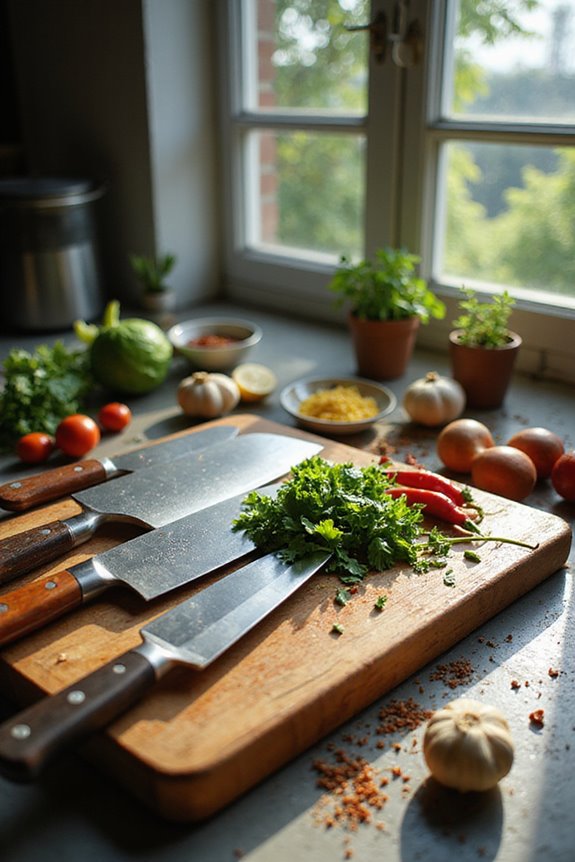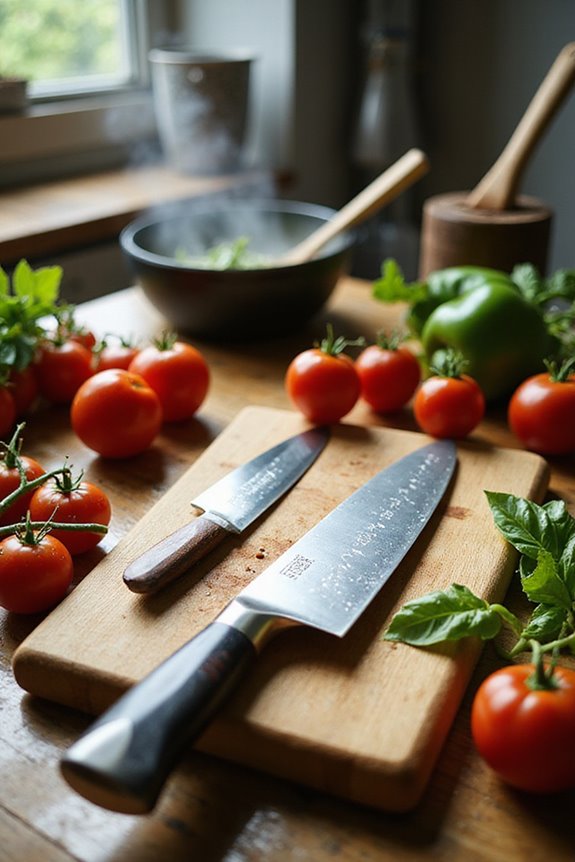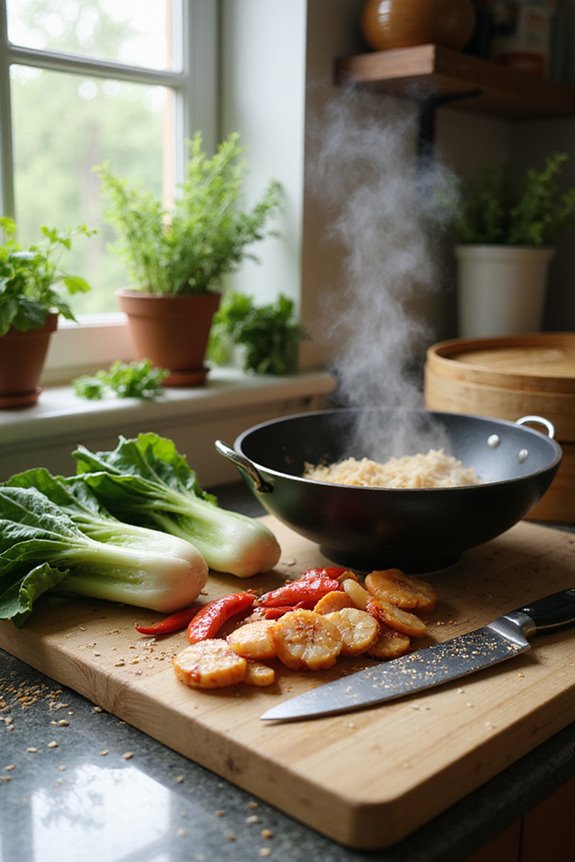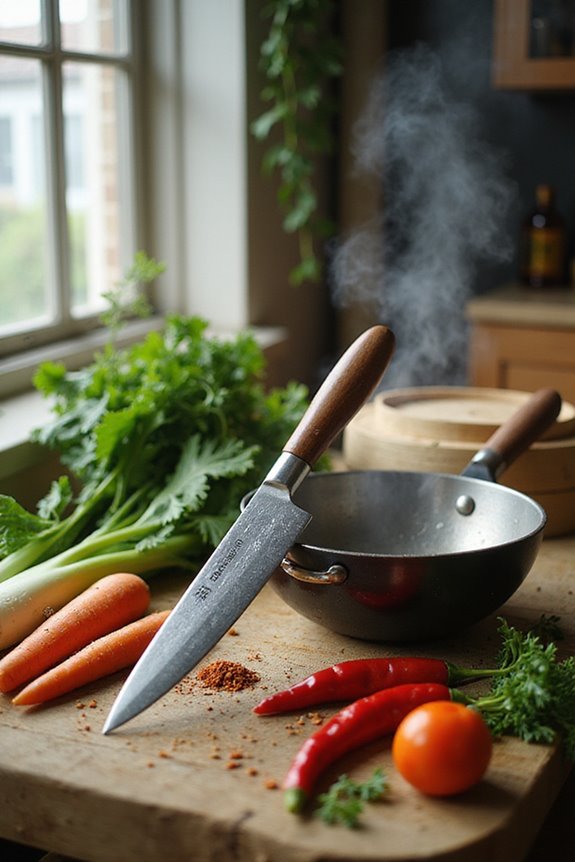As an Amazon Associate, we earn from qualifying purchases. Some links may be affiliate links at no extra cost to you. Although our opinions are based on curated research, we haven't used these products. Articles generated with AI.
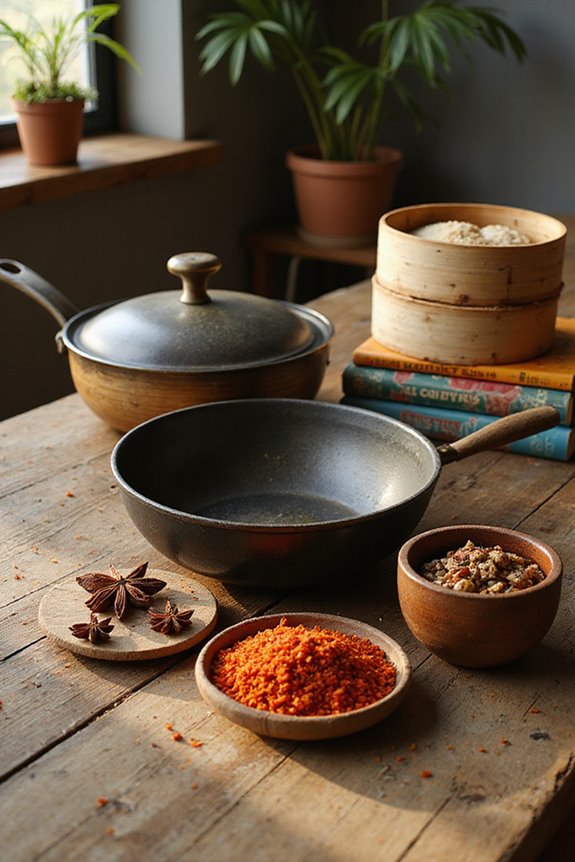
3 Best Pollinator Garden Designs to Attract Bees and Butterflies This Spring
To attract bees and butterflies this spring, design your pollinator garden with a variety of native flowering plants that bloom at different times. Create layered plant arrangements to enhance visibility and accessibility for pollinators. Incorporate water sources, like shallow dishes, in sunny spots to encourage visits. Finally, avoid harmful pesticides by using organic gardening methods. With these strategic choices, you’ll enjoy a vibrant habitat that supports local ecosystems. Keep exploring for additional expert tips and ideas!
Key Takeaways
- Incorporate a diverse selection of native flowering plants that bloom in succession for continuous nectar availability throughout spring.
- Design layered plantings, arranging taller species in the back and shorter ones in front to create a visually appealing and functional habitat.
- Include water sources such as shallow dishes or small ponds, placed in sunny spots to attract visiting pollinators.
- Maintain pesticide-free zones to promote a safe environment for bees and butterflies by utilizing integrated pest management (IPM) strategies.
- Ensure proper drainage and soil quality through testing and amendments, supporting healthy plant growth and attracting pollinators effectively.
The Pollinator Garden Planning Deck (109-Card Box Set)
Sale
The Pollinator Garden Planning Deck: Build a Thriving Habitat for Bees, Birds, and Butterflies (A...
- Katz, Cathy (Author)
- English (Publication Language)
- 109 Pages - 02/27/2024 (Publication Date) - Princeton Architectural Press (Publisher)
If you’re passionate about nurturing pollinators like bees, birds, and butterflies in your garden, the Pollinator Garden Planning Deck is tailored just for you. This 109-card box set is designed to make planning your pollinator garden both easy and effective. Each card provides valuable insights into suitable plants and gardening techniques that can attract and support these essential species. Users have shared positive experiences, praising the deck for its guidance and practicality. With this resource in hand, you’ll feel empowered to take action, transforming your garden into a thriving habitat that enhances pollinator populations and boosts biodiversity.
Best For: Individuals who are passionate about gardening and want to create a habitat that supports bees, birds, and butterflies.
Pros:
- Provides extensive information on plants and techniques specifically for attracting pollinators.
- Users report high satisfaction with the deck’s effectiveness in aiding their garden planning.
- Encourages immediate action, helping users implement their long-standing garden ideas.
Cons:
- May require some initial investment in time to familiarize oneself with all 109 cards.
- Might be overwhelming for beginners due to the extensive information provided.
- The success of the garden also depends on local climate and conditions, which may not be covered in depth.
Bird and Pollinator Habitat Yard Sign (8×12 inches)
vfsxcmi Bird and Pollinator Habitat Pesticide Free Yard Sign With Stakes 8X12 inches Rustproof...
- Reliable Material: Our "Bird and Pollinator Habitat "yard sign with stakes is crafted from durable, weather-resistant and reflective aluminum. It can withstand various...
- Eye-catching Design: Our "Bird and Pollinator Habitat" yard sign features a vibrant and appealing design that easily catches the attention of passersby. With colorful...
- Versatile Placement: Ideal for placement in various outdoor settings like front yards, backyards, community gardens, or even near schools and parks. informing neighbors...
For gardeners and nature enthusiasts keen to support local wildlife, the Bird and Pollinator Habitat Yard Sign (8×12 inches) is an ideal choice. Made from rustproof reflective aluminum, this durable sign measures just right for visibility, featuring vibrant graphics of bees, butterflies, and hummingbirds. Weighing only 7.4 ounces, it easily withstands weather elements, ensuring longevity in your garden. Installation is a breeze with pre-drilled holes and sturdy stakes that secure it in place. More than just decoration, this sign educates passersby on the essential role of pollinators, fostering community awareness and encouraging participation in protecting these critical creatures.
Best For: Gardeners, nature enthusiasts, and communities looking to promote awareness and support local pollinators.
Pros:
- Durable, weather-resistant materials ensure longevity and withstand various weather conditions.
- Eye-catching design with vibrant colors helps raise awareness and beautify outdoor spaces.
- Easy installation process allows for quick setup without the need for specialized tools.
Cons:
- Customer rating of 3.9 out of 5 stars suggests mixed reviews from some buyers.
- The size of 8×12 inches may not be large enough to catch the attention of distant passersby.
- Limited to educational purposes and may not serve as a strong deterrent against pests on its own.
Pollinator Friendly Gardening Book
Sale
Pollinator Friendly Gardening: Gardening for Bees, Butterflies, and Other Pollinators
- Insects, Pollinators, Landscape Design
- Fleming Hayes, Rhonda (Author)
- English (Publication Language)
A key feature of the “Pollinator Friendly Gardening” book is its hands-on approach, making it an ideal choice for both novice and seasoned gardeners who want to enhance their outdoor spaces while supporting essential pollinator populations. This thorough guide outlines the importance of pollinator habitats and provides extensive plant lists tailored for butterflies and bees at various life stages. With expert insights and practical planting tips, it’s a go-to resource for effective pollinator garden maintenance. Beautiful photographs inspire you to create inviting spaces. Despite some small print, this book is a valuable addition to any gardener’s library, merging practical advice with aesthetic inspiration.
Best For: Individuals and industries interested in creating gardens that support and enhance pollinator populations, including novice and experienced gardeners.
Pros:
- Comprehensive resource providing extensive plant lists and expert insights tailored for various pollinators at different life stages.
- Visually appealing with beautiful photographs that inspire creativity and transformation of outdoor spaces.
- Practical guidance on pollinator garden maintenance and alternatives to pesticides, promoting eco-friendly gardening practices.
Cons:
- Small text size may be challenging for some readers, potentially hindering usability.
- Focused on specific plants which may limit options for gardeners not interested in the highlighted species.
- Information density might overwhelm novice gardeners who are unfamiliar with gardening terminology or practices.
Factors to Consider When Choosing Pollinator Garden Designs
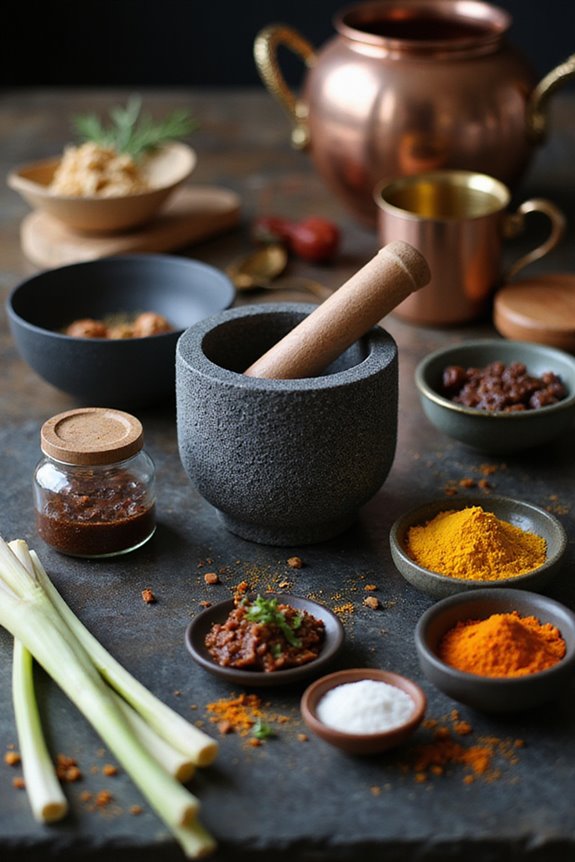
When you choose a design for your pollinator garden, consider key factors like plant selection diversity and sunlight needs. You’ll want to account for soil quality, drainage, and available water sources to guarantee a thriving environment. Finally, think about your design layout and how much space you have, as these elements are essential for attracting and supporting pollinators.
Plant Selection Diversity
To create a successful pollinator garden, thoughtful plant selection diversity is key, as it invites a variety of pollinators to thrive. Start by including a mix of flowering plants that bloom at different times throughout the season to guarantee a continuous food source. Focus on native plants, as they’re adapted to your local ecosystem and best support local pollinators. Incorporate larval host plants for caterpillars, along with nectar-rich flowers for adult pollinators, fostering their life cycles and enhancing biodiversity. Additionally, using a variety of plant heights, colors, and forms not only beautifies your garden but also provides unique habitats and foraging opportunities, making your garden a welcoming sanctuary for bees, butterflies, and hummingbirds alike.
Sunlight and Shade Needs
Understanding the sunlight and shade needs of your pollinator garden is vital for creating a thriving habitat. Most flowering plants that attract pollinators prefer full sun, needing at least six hours of direct sunlight daily. If your garden has partial sunlight, consider shade-tolerant plants, but make sure they’re known to attract pollinators. Mixing sun and shade can enhance your garden’s diversity, supporting various pollinators by incorporating suitable plants. It’s also important to understand seasonal sunlight patterns since sunlight angle changes throughout the year, impacting plant growth and pollinator presence. Regularly monitoring your garden’s sunlight exposure will help you adjust your plant selections and arrangements, optimizing conditions to draw in and maintain thriving pollinator populations.
Soil Quality and Type
Soil quality is essential for a successful pollinator garden because it directly impacts the health of your plants and the pollinators they attract. Different types of pollinator-friendly plants thrive in sandy, loamy, or clay soils, so it’s vital to match your plant selections with your existing soil conditions. To enhance plant growth, aim for a soil pH between 6.0 and 7.0, which most pollinator plants prefer. Conducting a soil test can help you identify nutrient deficiencies and necessary amendments. Healthy soil rich in organic matter will improve water retention and drainage, supporting pollinator plants even during dry spells or heavy rainfall. By ensuring good soil quality, you’ll create a thriving habitat for bees and butterflies.
Water Sources and Drainage
How can you best create effective water sources and drainage in your pollinator garden? Start by adding accessible water features like shallow dishes or small ponds, which are essential for bees, butterflies, and birds, especially during dry spells. Make sure these water sources have proper drainage to prevent waterlogging, as this can harm plant roots and deter pollinators. Including a variety of features enhances biodiversity, since different species prefer different hydration types. Regular maintenance is important—clean out algae and keep the water fresh to attract and retain pollinators. Finally, consider sunlight exposure; placing water sources in sunny spots makes them more inviting, encouraging pollinators to visit your garden.
Design Layout and Space
After guaranteeing your pollinator garden has adequate water sources and proper drainage, the next step involves thoughtful design layout and space planning. Evaluate your available space, focusing on sunlight exposure, soil type, and water drainage, as these factors directly influence your plant choices. Incorporating diverse species that bloom at various times guarantees a continuous food supply for pollinators. When arranging your plants, consider their height and spread to prevent taller plants from overshadowing smaller ones, creating a layered effect. Design pathways or open areas to allow easy movement for pollinators, and arrange plants in clusters to attract more bees and butterflies, encouraging them to linger in your beautiful garden. This blend of functionality and aesthetics is key for successful pollinator gardening.
Seasonal Blooms Planning
When planning your pollinator garden, it’s essential to contemplate seasonal blooms to provide a steady food source for visiting bees and butterflies. Start with early bloomers like crocuses and snowdrops, offering much-needed nectar for bees waking from hibernation. For mid-season, consider incorporating coneflowers and milkweed, as these attract a wide variety of pollinators and support their populations during peak activity. Don’t forget late-season bloomers like asters and goldenrods; these are vital for helping pollinators build reserves for winter. Additionally, selecting native plants that thrive in your local climate will enhance your garden’s success, ensuring a continuous and accessible food supply for pollinators throughout the growing season.
Pesticide Use Considerations
Creating a pollinator-friendly garden doesn’t just stop at choosing the right flowers; it also involves thoughtful consideration of how pest control methods impact the very creatures you’re trying to attract. Pesticides can harm bee and butterfly populations, threatening garden health and food production. Instead, consider Integrated Pest Management (IPM) practices that minimize pesticide use, effectively managing pests without harming pollinators. Opting for organic gardening methods avoids synthetic pesticides, creating safer habitats and encouraging biodiversity. Establishing pesticide-free zones not only supports these important insects but also promotes natural pest control through beneficial insects. Take time to educate yourself about the effects of various pesticides on pollinators, leading to more informed decisions that foster a thriving garden ecosystem.
Frequently Asked Questions
How Do I Care for My Pollinator Garden Throughout the Seasons?
To care for your pollinator garden throughout the seasons, start by regularly checking for weeds and pests. In spring, plant a variety of flowers that bloom at different times. During summer, water your plants consistently, especially in dry spells. As fall approaches, reduce your water and consider cutting back some perennials. In winter, leave seed heads for birds and avoid cleaning up too much, allowing natural habitats for pollinators.
What Are Some Common Pests That Affect Pollinator Gardens?
Common pests that affect pollinator gardens include aphids, spider mites, and whiteflies. These pests can sap your plants’ energy, reducing their appeal to pollinators. You can manage them by introducing beneficial insects like ladybugs or using insecticidal soap. Regular monitoring is essential; check for signs of infestation frequently. Additionally, maintain plant health through proper watering and nutrition, as robust plants are less susceptible to pests. Keep your garden thriving by staying proactive against these nuisances.
Can I Include Non-Native Plants in My Pollinator Garden?
You might wonder if non-native plants can be useful in your pollinator garden. While native plants are best for local wildlife, certain non-natives can still attract pollinators effectively. Just guarantee these plants don’t outcompete local species or disrupt the ecosystem. When choosing non-natives, seek those known to benefit pollinators, like certain cultivars or ornamental varieties. Balancing your garden with both types can create a vibrant, pollinator-friendly space throughout the seasons.
How Do I Create a Water Source for Pollinators?
Creating a water source for pollinators is simple. You can use a shallow dish filled with pebbles and fresh water. The pebbles provide resting spots, keeping tiny pollinators safe and allowing them to access the water. Make sure you change the water regularly to prevent stagnation. Another option is a small birdbath with a gentle slope. Position your water source in a sunny area, but avoid direct sunlight to prevent overheating.
What Are Native Plants That Attract Specific Types of Bees?
To attract specific types of bees, focus on native plants that meet their needs. For example, bumblebees love dense patches of purple coneflower or bee balm. Honeybees are drawn to flowering herbs like thyme and oregano. Meanwhile, mason bees favor early-blooming plants, such as willow and fruit trees. Always choose plants that provide a range of flower shapes, colors, and blooming times to create a buzzing haven for your local bee populations.




